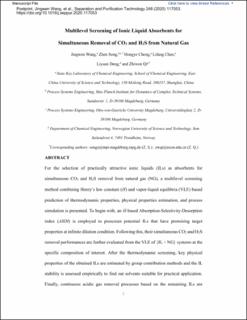| dc.contributor.author | Wang, Jingwen | |
| dc.contributor.author | Song, Zhen | |
| dc.contributor.author | Cheng, Hongye | |
| dc.contributor.author | Chen, Lifang | |
| dc.contributor.author | Deng, Liyuan | |
| dc.contributor.author | Qi, Zhiwen | |
| dc.date.accessioned | 2020-09-07T12:39:35Z | |
| dc.date.available | 2020-09-07T12:39:35Z | |
| dc.date.created | 2020-09-03T14:25:56Z | |
| dc.date.issued | 2020 | |
| dc.identifier.citation | Separation and Purification Technology. 2020, 248 117053-?. | en_US |
| dc.identifier.issn | 1383-5866 | |
| dc.identifier.uri | https://hdl.handle.net/11250/2676692 | |
| dc.description.abstract | For the selection of practically attractive ionic liquids (ILs) as absorbents for simultaneous CO2 and H2S removal from natural gas (NG), a multilevel screening method combining Henry′s law constant (H) and vapor–liquid equilibria (VLE) based prediction of thermodynamic properties, physical properties estimation, and process simulation is presented. To begin with, an H-based Absorption-Selectivity-Desorption index (ASDI) is employed to prescreen potential ILs that have promising target properties at infinite dilution condition. Following this, their simultaneous CO2 and H2S removal performances are further evaluated from the VLE of {IL + NG} systems at the specific composition of interest. After the thermodynamic screening, key physical properties of the obtained ILs are estimated by group contribution methods and the IL stability is assessed empirically to find out solvents suitable for practical application. Finally, continuous acidic gas removal processes based on the remaining ILs are simulated and compared by Aspen Plus, thereby identifying the best ILs from the process point of view. | en_US |
| dc.language.iso | eng | en_US |
| dc.publisher | Elsevier | en_US |
| dc.rights | Attribution-NonCommercial-NoDerivatives 4.0 Internasjonal | * |
| dc.rights.uri | http://creativecommons.org/licenses/by-nc-nd/4.0/deed.no | * |
| dc.title | Multilevel Screening of Ionic Liquid Absorbents for Simultaneous Removal of CO2 and H2S from Natural Gas | en_US |
| dc.type | Peer reviewed | en_US |
| dc.type | Journal article | en_US |
| dc.description.version | acceptedVersion | en_US |
| dc.source.pagenumber | 117053-? | en_US |
| dc.source.volume | 248 | en_US |
| dc.source.journal | Separation and Purification Technology | en_US |
| dc.identifier.doi | 10.1016/j.seppur.2020.117053 | |
| dc.identifier.cristin | 1827106 | |
| dc.description.localcode | © 2020. This is the authors’ accepted and refereed manuscript to the article. Locked until 7.5.2022 due to copyright restrictions. This manuscript version is made available under the CC-BY-NC-ND 4.0 license http://creativecommons.org/licenses/by-nc-nd/4.0/ | en_US |
| cristin.ispublished | true | |
| cristin.fulltext | postprint | |
| cristin.qualitycode | 1 | |

